

- Home
- Companies
- Heatsystems GmbH & Co. KG
- Products
- Heatsystems - Industrial Liquid Tank ...

Heatsystems - Industrial Liquid Tank Heater
The tank heaters developed by heatsystems GmbH & Co. KG are specifically engineered for the efficient heating of liquid fluids in industrial applications. These heaters convert electrical energy within heating rods into thermal energy, which is then transferred to the fluid. Essential to their design is the adaptation to the fluid's specific properties and desired operating conditions, ensuring effective thermal transfer and prevention of corrosion. The system can include built-in controls for low power or require external switchgear, depending on the installation. Materials used for heating and unheated surfaces must resist corrosion, demanding careful selection based on the fluid's chemical properties. These systems are often furnished with options like cable connections sealed by screwed glands and may incorporate suction lines or various fluid connections to facilitate installation. Overall, each design balances durability and effective heat transfer catered to the user's system requirements.
The tank heaters are designed for efficiently heating liquid fluids. The design is based on the general conditions such as the type and properties of the respective fluid and temperature as well as the desired operating points in the process.
Tank heaters directly heat fluids. To this effect, electrical energy in the heating rods is converted to thermal energy. The thermal energy is then transferred from the heating rods to the fluid. Here, it is important that the design be matched to the general conditions, for each fluid has its specific properties.
For example, these fluids are heated with electrical tank heaters:
I. Water
- Drinking water, max. surface load depending on the water hardness 4 – 6 W/cm²
- Circulating and/or heating water, max. surface load approx. 10 W/cm²
- Softened water, observe the maximally admissible chloride content, max. surface load approx. 10 W/cm²
- Fully desalted water; here, non-ferrous heavy metals should not be used, maximum surface load approx. 10 W/cm²
II. Oil
- Heavy oil, not pumpable in a cold condition, maximum surface load between 1 and 2 W/cm² depending on the quality
- Hydraulics oil, maximum surface load approx. 0.6 – 1.2 W/cm²
- Lubricating oil, steam turbine oil, max. surface load approx. 1 W/cm²
- Fuel oil, diesel, heating to max. 40 °C, max. surface load approx. 4 W/cm²
The fluid to be heated and the application temperature mainly define the materials which can be used for the unheated and/or heated surfaces. Otherwise, corrosion may quickly result in a failure of the tank heater, for example.
Materials of the wetted and unheated components
- Carbon steel
- Corrosion-resistant stainless steel
- Heat-resistant stainless steel
- Titanium, Hastelloy, special materials
- Brass
Materials of the heating surface:
- Carbon steel
- Corrosion-resistant stainless steel
- Heat-resistant stainless steel
- Titanium, Hastelloy, special materials
Supply and/or supply protection
- Cables
- Riser with internal cable
Normally, sturdy heating elements are used for tank heaters.
I. Heating elements
- Tubular heaters 16 mm
- Cartridge-type heaters, diameter 16, 18 or 25 mm
Electrical tank heaters can both be equipped with a built-in control system (for low power) or an external switchgear cabinet or for load switching by customer-provided switchgear and control gear. The electrical heating power can be divided into one or several heating stages. This division can individually be adjusted to match the control equipment.
I. Controllers
- Control. (-> ON-OFF control switches off the heater if the temperature is exceeded, and switches it on again when the temperature falls below its lowest value. Thus, the temperature will always oscillate around the setpoint. The algorithm of the PID controller will optimally compensate the control fluctuations.)
- Load switching by contactors or wear-free semiconductors (thyristors). (-> contactors are wearing parts and must be replaced after approx. 100,000 make/break operations; thyristors switch quickly and without any wear but generate more heat losses than contactors.)
- Electromechanical control.
Thermostats installed in the electrical flow-type heater are price-efficient controllers whose accuracy is sufficient for many applications.
II. Sensors
- Thermal protectors and limiters as capillary thermostats (as a safety design as well).
- Temperature sensors for the fluid and heating rod temperature.
Tank heaters with low power can be designed with a cable connection. The cable is then sealed against the tank by a screwed cable gland in most cases.
If the tank heater is equipped with a riser or a protective hose including cable connection, the mechanical performance of the installation or sealing of the tank must be agreed with us.
Optionally, the tank heaters can be equipped with a suction line. The following connections are available:
I. Fluid connections
- Standard flanges (DIN, ASME, SAE etc.)
- Female or male thread connections
